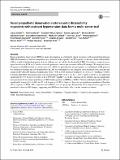Renal sympathetic denervation restores aortic distensibility in patients with resistant hypertension: data from a multi-center trial
Author(s)
Stoiber, Lukas; Zamani, Seyedeh M; Lapinskas, Tomas; Böhm, Michael; Ewen, Sebastian; Kulenthiran, Saarraaken; Schlaich, Markus P; Esler, Murray D; Hammer, Tommy; Stensæth, Knut H; Pieske, Burkert; Dreysse, Stephan; Fleck, Eckart; Kühne, Titus; Kelm, Marcus; Stawowy, Philipp; Kelle, Sebastian; Zamani, Seyedeh Mahsa; Schlaich, Markus P.; Esler, Murray D.; Stensæth, Knut Haakon; Mahfoud, Felix; ... Show more Show less
Download392_2018_Article_1229.pdf (787.4Kb)
PUBLISHER_CC
Publisher with Creative Commons License
Creative Commons Attribution
Terms of use
Metadata
Show full item recordAbstract
Renal sympathetic denervation (RDN) is under investigation as a treatment option in patients with resistant hypertension (RH). Determinants of arterial compliance may, however, help to predict the BP response to therapy. Aortic distensibility (AD) is a well-established parameter of aortic stiffness and can reliably be obtained by CMR. This analysis sought to investigate the effects of RDN on AD and to assess the predictive value of pre-treatment AD for BP changes. We analyzed data of 65 patients with RH included in a multicenter trial. RDN was performed in all participants. A standardized CMR protocol was utilized at baseline and at 6-month follow-up. AD was determined as the change in cross-sectional aortic area per unit change in BP. Office BP decreased significantly from 173/92 ± 24/16 mmHg at baseline to 151/85 ± 24/17 mmHg (p < 0.001) 6 months after RDN. Maximum aortic areas increased from 604.7 ± 157.7 to 621.1 ± 157.3 mm[superscript 2] (p = 0.011). AD improved significantly by 33% from 1.52 ± 0.82 to 2.02 ± 0.93 × 10[superscript −3] mmHg[superscript −1] (p < 0.001). Increase of AD at follow-up was significantly more pronounced in younger patients (p = 0.005) and responders to RDN (p = 0.002). Patients with high-baseline AD were significantly younger (61.4 ± 10.1 vs. 67.1 ± 8.4 years, p = 0.022). However, there was no significant correlation of baseline AD to response to RDN. AD is improved after RDN across all age groups. Importantly, these improvements appear to be unrelated to observed BP changes, suggesting that RDN may have direct effects on the central vasculature. Keywords:
Renal denervation, Aortic distensibility, Compliance, Vascular stiffness, Cardiovascular magnetic resonance, CMR, Resistant hypertension
Date issued
2018-03Department
Institute for Medical Engineering and ScienceJournal
Clinical Research in Cardiology
Publisher
Springer Berlin Heidelberg
Citation
Stoiber, Lukas, et al. “Renal Sympathetic Denervation Restores Aortic Distensibility in Patients with Resistant Hypertension: Data from a Multi-Center Trial.” Clinical Research in Cardiology, Mar. 2018. © 2018 The Authors
Version: Final published version
ISSN
1861-0684
1861-0692